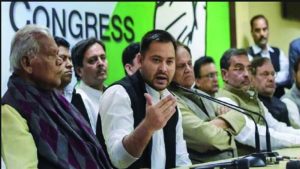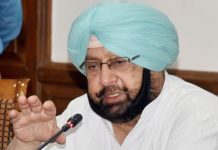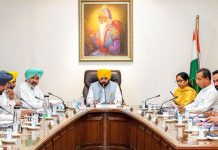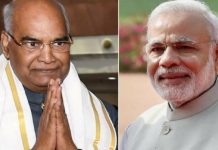 The ongoing Lok Sabha poll, with its fourth-phase of the seven-phase election being over, holds specific significance for Bihar where there was direct contest between the National Democratic Alliance (NDA) and Mahagathbandhan. NDA in Bihar is represented by the BJP, JD (U), and LJP led by Ram Vilas Paswan. While Mahagathbandhan comprises RJD, Congress, HAM, RSLP, VIP and CPI (M-L). Interestingly, the tone and tenor of the ongoing electoral campaign in Bihar and Uttar Pradesh is different and distinct from the rest of country.
The ongoing Lok Sabha poll, with its fourth-phase of the seven-phase election being over, holds specific significance for Bihar where there was direct contest between the National Democratic Alliance (NDA) and Mahagathbandhan. NDA in Bihar is represented by the BJP, JD (U), and LJP led by Ram Vilas Paswan. While Mahagathbandhan comprises RJD, Congress, HAM, RSLP, VIP and CPI (M-L). Interestingly, the tone and tenor of the ongoing electoral campaign in Bihar and Uttar Pradesh is different and distinct from the rest of country.
While in the rest of the country, the electorates are focusing on the candidate or the party represented by him/her whereas in Bihar and UP, the option before the electorate is between the persona of PM Modi and social engineering. However, this scenario has emerged as the defining feature of the election campaign more prominently in Bihar. Caste configuration of Bihar society has forced the major contesting parties to reinvent the mechanism of social engineering to attract voters.
The caste factor has been a defining feature of Bihar politics and it has played decisive role in the selection of candidates by both the NDA and the Mahagathbandhan. More than half of Bihar’s constituencies have sizable SC/ST populations that entails the likelihood of playing a pivotal role in the outcome of the polls on all 40 Lok Sabha seats. The Other Backward Castes (OBCs) and Extremely Backward Class (EBCs) form 51 per cent of the state’s population. This includes 14 per cent Yadavs, 4 per cent Kurmis and 8 per cent Kushwahas (Koeri). At least 16 per cent of Bihar’s population is Mahadalit and Dalits (SCs) while 16.9 per cent of population is Muslim. Forward caste constitutes 15 per cent.
NDA’s prospects
The NDA has fielded its candidate on 40 Lok Sabha seats of Bihar. While the BJP, contesting 17 seats, is focusing on the political combination of upper castes, JDU, also contesting 17 seats is concentrating on non-Yadav OBCs, particularly MBC votes; and LJP is depending on Paswan votes. The BJP has named 11 of its 17 candidates from the upper castes, which are considered the party’s traditional support base. A close scrutiny of local media reports makes it discernible that of the 11 upper caste candidates fielded by the BJP, five are Rajputs, two each from Brahmin and Vaishya communities and one each from Bhumihar and Kayastha. It has also fielded two from Extremely Backward Castes (EBCs) and one from the Scheduled Castes (SCs) keeping in mind the winnability factor.
On the other hand, JD (U) is heavily banking on the OBCs and EBCs along with the SCs, which together constitute a sizeable chunk of the total population. Some political analysts have opined that the NDA has made efforts to adjust every section of society in the ticket distribution with a view to outdo the caste matrix of the Mahagathbandhan. Sources close to the NDA have apprised this author that NDA is sanguine about reaping good electoral dividends owing to the BJP’s traditional support base of upper castes, JD (U)\s non-Yadav OBCs like Kurmi and EBCs. Besides, the coalition is also banking on PM Modi’s charisma, chief minister Nitish Kumar’s image of a Vikas Purush and social engineering of the allies.
This author during his recent tour of many districts of Bihar was told by the BJP and NDA sources that PM Modi’s persona is popular with a large chunk of Bihar’s young voters, who, across castes, are seemingly rooting resolutely for Modi in the 2019 elections. In his brief interaction with this author, the BJP candidate from Begusarai Giriraj Singh stated that if polling percentage of votes exceeded 65 per cent, he could win the seat with a margin of over five lakh votes. Similar victory confidence was reiterated to this author by Ravi Shankar Prasad, the BJP candidate from Patna Sahib constituency where he is pitted against veteran Bollywood actor and former BJP MP Shatrughan Sinha, now contesting on Congress ticket.
Some critics are of the view that Modi’s charisma and Nitish government’s credibility would give an edge to the NDA over Mahagathbandhan in the ensuing polls. They also allude to Modi’s popularity with the youth and their disenchantment with Mahagathbandhan’s only plank of Modi Hatao. However, this argument is rebutted by many critics who aver that RJD’s strategy of allying with HAM, RSLP and VIP is likely to take wind out of NDA’s sail.
Mahagathbandhan’s potential
The Mahagathbandhan is also contesting all 40 seats of the Lok Sabha, with RJD contesting 20 seats, with one seat given to CPI (M-L), Congress allocated 9 seats, the Rashtriya Lok Samata Party (RLSP) given 5 seats, Hindustani Awam Morcha (HAM)allocated 3 seats and Vikasheel Insaan Party (VIP) also given 3 seats. RJD is hopeful of expanding its social base with the help of political equation of M-Y (Muslim-Yadav) factor accountingfor 32 per cent of Bihar’s total population along with cooperation from smaller allies like HAM, RSLP and VIP. Broadly speaking, every part of Bihar entails its own significance in state politics because of its demographic features.
According to some critics, the potential of caste dynamics in Bihar politics can be discerned from the fact that RJD, the major constituent of the Mahagathbandhan, had to concede 11 seats to caste-based political outfits of backwards and Mahadalits. In his brief interaction with this author, RJD leader Tejaswi Yadav said that his party along with other constituents of Mahagathbandhan were sure of winning more than 25 Lok Sabha seats. While ruling out the impact of Modi’s charisma, the RJD leader said that even the credibility of Nitish Kumar was also at stake owing to people’s growing disenchantment with the NDA rule in Bihar. Nonchalantly he said that
There will be clear washout of the JD (U) and the BJP will be limited to half of the seats as compared to what it won in 2014. According to some political analysts, the Congress is also gaining some its lost ground in Bihar, especially among the upper castes in the aftermath of restructuring of the state unit of the Congress by All India Congress Committee (AICC) recently when party appointed MLC Madan Mohan Jha as state president and Rajya Sabha MP Akhilesh Singh as chairman of the campaign committee. Both the leaders are said to command a massive support of two dominant and numerically significant communities — Brahmin and Bhumihar.
Appointment of two upper caste veterans to the top post was also seen as Congress party’s move to mobilise upper caste voter base and upset the caste calculations of NDA in Bihar. Analysts also opine that the upper caste voters remained loyal to the BJP till 2014, but started moving away in 2015 when 12 out of 16 upper caste leaders fielded by the Congress won during the Assembly elections.
Validation of prognosis
Dynamics of social engineering pioneered by Lalu Prasad Yadav nearly four decades ago still constitutes the pivot around which politics revolves in Bihar. This dynamics is so strong that the BJP despite its USP of Brand Modi has to adhere to social engineering to counter the influence of the RJD. Some observersopine that Lalu hanged the social and political configuration of Bihar that has made him one of the most important political and social figures in the state and he continues to a decisive factor in state politics even today. Lalu’s bold initiatives like stopping Advani’s rath-yatra, social engineering and social justice helped him garner influence in the national polity and his appeal extended even beyond India.
Foundations for social justice in Bihar had been laid down by Karpoori Thakur, who provided an ideological thrust to it and other leaders like Bhola Paswan Shastri. Jaglall Chowdhury and Sahajanand etc. galvanized the Bihar society through social agenda; nevertheless, these social groups were not a significant part of he overall state system. However, as chief minister of Bihar, Lalu made Lower backwards electorally relevant and got them elected as MLAs and MPs.
The Mandal Commission helped Lalu to expand his social base and brought social justice on the national agenda. As one expert has opined, by making Lower Backwards electorally relevant and as a part of the state structure, Lalu not only generated a wide electoral support base for himself but also made Bihar possibly the only state in India where feudal or elite castes cannot wrest power in the near future, overtly or covertly. This prognosis of social engineering set in motion by Lalu still holds water in Bihar politics where despite PM Modi’s charisma, the BJP has to engage itself in social engineering.
Way ahead
Bihar presents an interesting example of parliamentary elections this time where unlike other states of the country, there is a bilateral contest between Modi’s charisma and the constituents of the Grand Alliance or Mahagathbandhan. RJD along with resurgent Congress and other smaller parties together are going to give the NDA a run for its money. Authentication of Lalu Prasad Yadav’s prognosis of social engineering can be seen from the fact that despite the claims of charisma of Modi and credibility of Nitish Kumar, the NDA is forced to seriously work out its strategy of social engineering to counter Mahagathbandhan.
The author is Executive Editor of News24. Views expressed are his own
letters@tehelka.com












